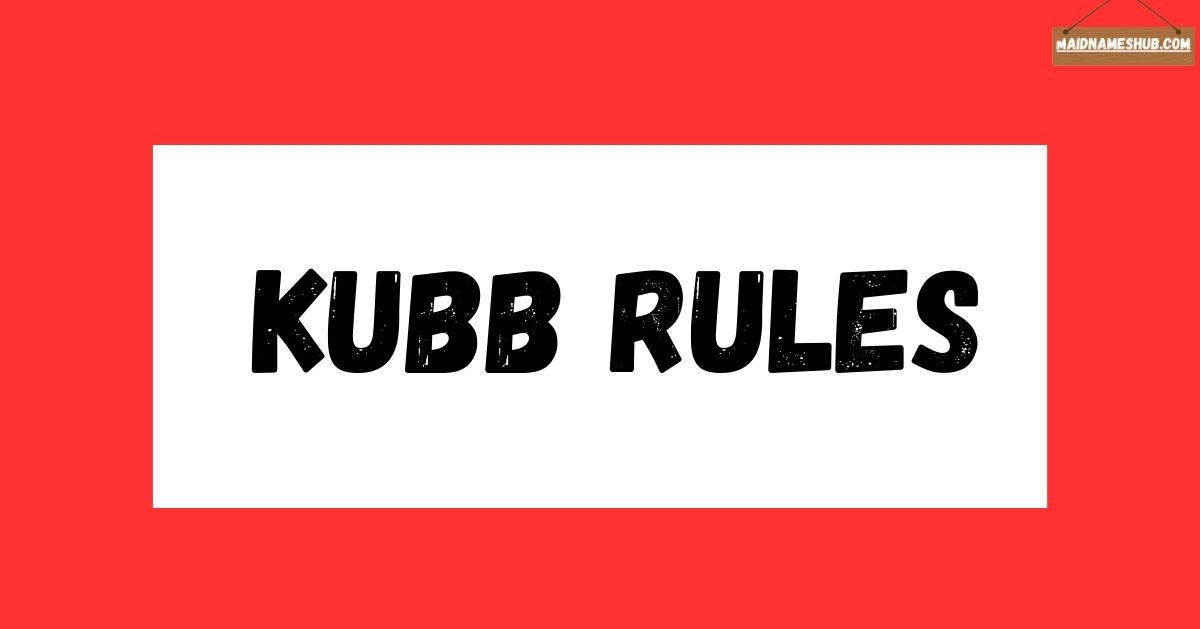Kubb is a strategic lawn game that combines skill, precision, and teamwork. Originating from Sweden, it has gained massive popularity in the United States, particularly with the U.S. National Kubb Championship® held annually in Eau Claire, Wisconsin. Whether you’re a beginner or a seasoned player, understanding the kubb rules is essential to enjoy the game and compete effectively.
In this article, we will cover everything about kubb rules, including setup, gameplay phases, common terminology, tournament standards, and winning strategies. We will also answer frequently asked questions about field kubbs, baseline kubbs, the king, and punishment kubbs.
What is Kubb?
Kubb is sometimes described as a combination of bowling, horseshoes, and chess. The game is played on a rectangular pitch, where players throw wooden batons to knock over blocks of wood called kubbs, aiming ultimately to topple the king in the center.
The game emphasizes:
- Accuracy and strategy
- Teamwork and coordination
- Respect for the spirit of fair play
The U.S. National Kubb Championship® Rules are designed to ensure that every player, regardless of age or experience, enjoys a fair and competitive environment.
Kubb Rules: Basic Overview
The objective of Kubb is simple: topple all the kubbs on your opponent’s side of the pitch and then knock over the king. However, there are several detailed rules that make the game strategic and exciting.
1. Game Components
A standard Kubb set includes:
| Component | Official Tournament Size | Weight Range |
| 10 Kubbs | 7 x 7 x 15 cm | 0.3 – 0.5 kg each |
| 6 Batons | 30 cm x 4.4 cm diameter | 0.2 – 0.3 kg each |
| 1 King | 8 x 8 x 25–30 cm | 0.8 – 1.3 kg |
| Pitch Stakes | 6 pieces | N/A |
Teams: Minimum of 3 players per team, with substitutions allowed from registered team members.
2. Pitch Setup
Understanding the official Kubb pitch dimensions is crucial:
- Rectangle: 5 m wide x 8 m long
- King: Placed upright in the center
- Baseline Kubbs: 5 kubbs on each baseline, upright
- Centerline: Intersects the rectangle to divide the pitch
The baseline runs through the center of the kubbs, and corner stakes mark the boundaries. A proper setup ensures fair play according to tournament standards.
Gameplay Phases
A Kubb game consists of three main phases per turn:
- Baton Tossing Phase
- Kubb Tossing Phase (Field Kubbs)
- Kubb Raising Phase
A complete round includes two turns: each team attacks once and defends once.
Baton Tossing Phase
- Players throw batons underarm from behind their baseline.
- A baton must travel end-over-end vertically or in a straight path without horizontal rotation.
- Maximum rotation allowed: 45º off vertical.
- Only one baton is thrown at a time, with no player throwing more than two batons per round.
- Field kubbs and baseline kubbs are targeted strategically to progress toward the king.
Pro Tip: Always knock down field kubbs first before attacking baseline kubbs.
Kubb Tossing Phase (Field Kubbs)
After all batons are thrown, the defending team gathers any toppled kubbs from the opponent’s turn:
- These become field kubbs when thrown into the upfield.
- Kubbs may be thrown underarm in any rotation but must stay within the throwing area.
- A kubb landing outside the pitch may be thrown again. If it fails twice, it becomes a punishment kubb.
Punishment Kubbs: Can be placed anywhere in the defending team’s half, at least one baton length from the king and pitch stakes.
This phase adds strategy: placing kubbs cleverly can make it harder for opponents to knock them down.
Kubb Raising Phase
- Field kubbs must be raised on one end, ensuring two corners touch the ground (the footprint).
- If a kubb is obstructed by another kubb, the king, or a stake, it must be raised on the unobstructed end.
- Kubbs leaning or stacked are resolved carefully to maintain in-bounds positions.
Tip: Properly raising kubbs can prevent accidental losses and maintain control of the field.
Winning the Game
To win a Kubb match:
- Knock down all field kubbs in the opponent’s half.
- Knock down all baseline kubbs.
- Finally, knock over the king from your baseline.
Important: If the king is toppled before all kubbs are cleared, the attacking team immediately loses the game.
A match usually consists of the best of three games.
Common Kubb Terms
Understanding the terminology is essential for players:
- Base Kubb: Kubbs that start on the baseline.
- Field Kubb: Kubbs thrown into the opponent’s side during play.
- Punishment Kubb: Kubbs that cannot be raised in bounds after two throws.
- King: Central kubb; final target for victory.
- Throwing Area: The legal area in which batons must travel.
- Advantage Line: Created when field kubbs remain standing; attackers may throw from this line.
- Footprint: Area where a kubb touches the ground when raised.
Etiquette and Sportsmanship
The spirit of Kubb emphasizes:
- Respect for opponents and referees.
- Avoiding distractions or gestures during an opponent’s throw.
- Following legal throwing techniques.
- Maintaining safety on the pitch.
Penalties include:
- Warning → Game Penalty → Match Penalty
- Personal Ejection for serious violations
Following kubb rules ensures a fun and competitive environment for all players.
Read Must : Water Polo Rules: Complete Guide to Gameplay, Fouls, and Regulations (2025 Edition)
Frequently Asked Questions (NLP Queries)
Q1: How do you play Kubb?
A1: Players take turns throwing batons to knock down the opponent’s kubbs. Field kubbs are thrown back and raised strategically, aiming to eventually topple the king.
Q2: What are field kubbs and baseline kubbs?
A2: Baseline kubbs start on the baseline. Field kubbs are knocked down kubbs thrown back into the opponent’s half to continue gameplay.
Q3: How do you win at Kubb?
A3: Clear all field and baseline kubbs, then topple the king from your baseline. Toppling the king early results in an immediate loss.
Q4: What are punishment kubbs?
A4: Kubbs that cannot be raised legally after two throws. The defending team can place them strategically on their half of the pitch.
Q5: What are the official Kubb pitch dimensions?
A5: Tournament standard: 5 m wide × 8 m long, with corner and center stakes marking boundaries.
Strategy Tips for Kubb Players
- Target field kubbs first: They create obstacles for the opponent.
- Use advantage lines wisely: Move up to the line to shorten distance to field kubbs.
- Place punishment kubbs strategically: Make it difficult for the opposing team to attack effectively.
- Maintain control of the baseline: Avoid knocking over the king prematurely.
- Practice underarm throws: Precision beats power in Kubb.
Kubb in Tournaments
The U.S. National Kubb Championship® is held annually in Eau Claire, WI, known as the Kubb Capital of North America. Players of all ages and skill levels participate. The tournament uses:
- JP’s Backyard Games sets
- Standard pitch dimensions and kubb sizes
- Best-of-three games to determine match winners
Participating in tournaments emphasizes sportsmanship and fair play, in line with the spirit of Kubb.
Conclusion
Kubb is a fun, strategic game for family gatherings, backyard competitions, and professional tournaments alike. Learning and following the kubb rules ensures a fair, competitive, and enjoyable game for everyone.
Whether you’re practicing for a tournament or enjoying a casual match, remember that accuracy, strategy, and sportsmanship are the keys to victory.

“Flavia Finn – Content writer & SEO specialist with 3 years of experience. Crafting engaging, optimized content that delivers real results.” Offering writing services – contact for quality content “

